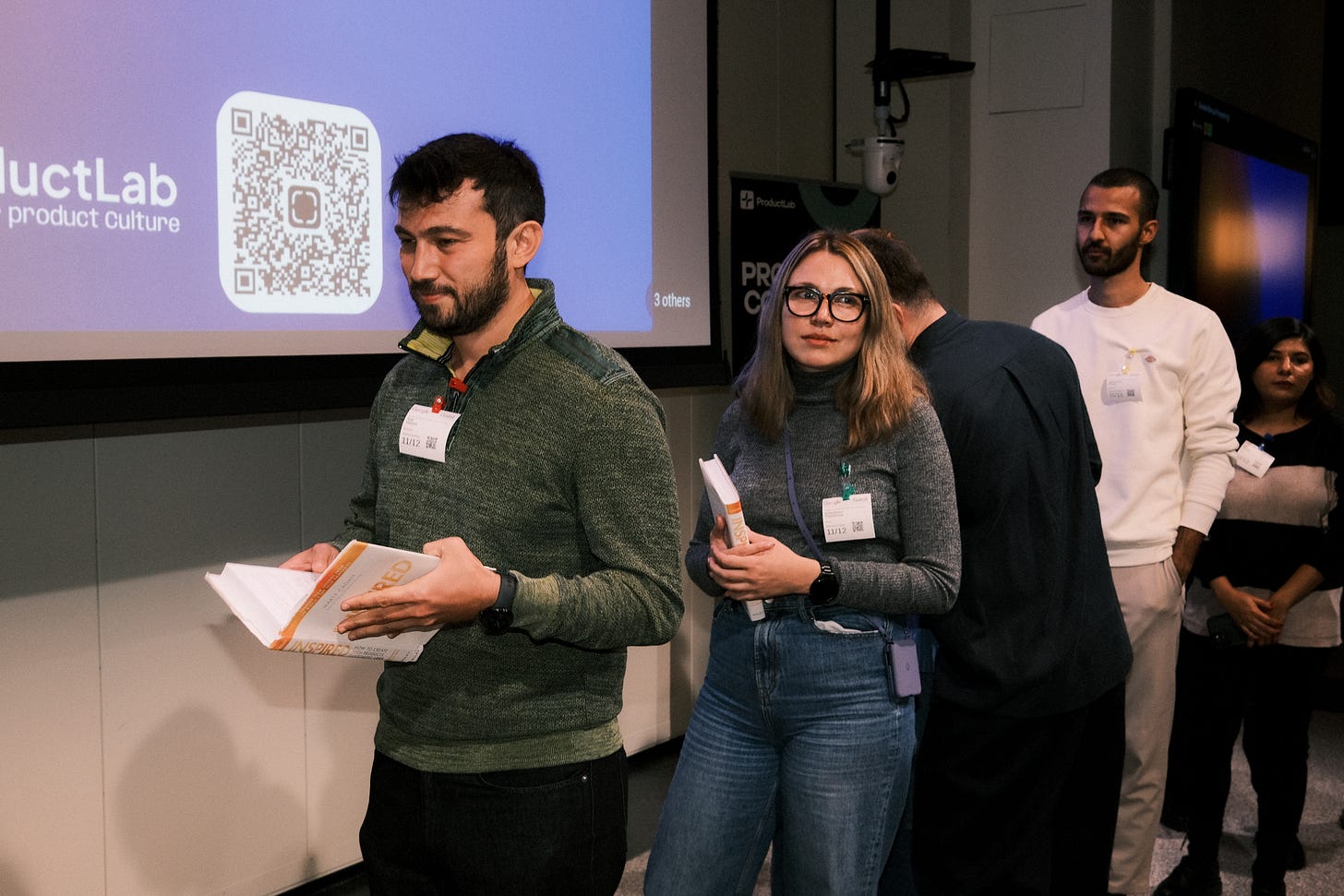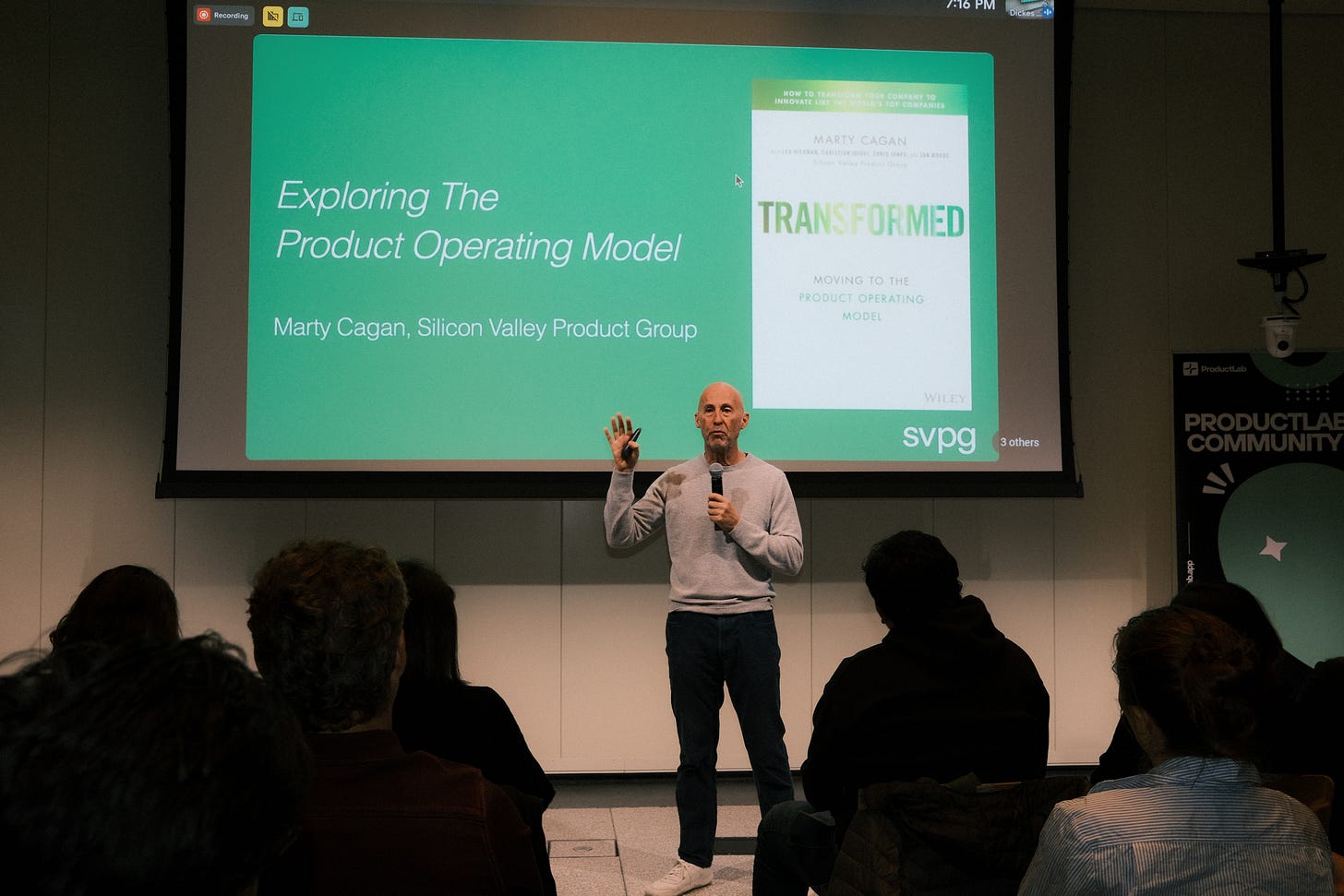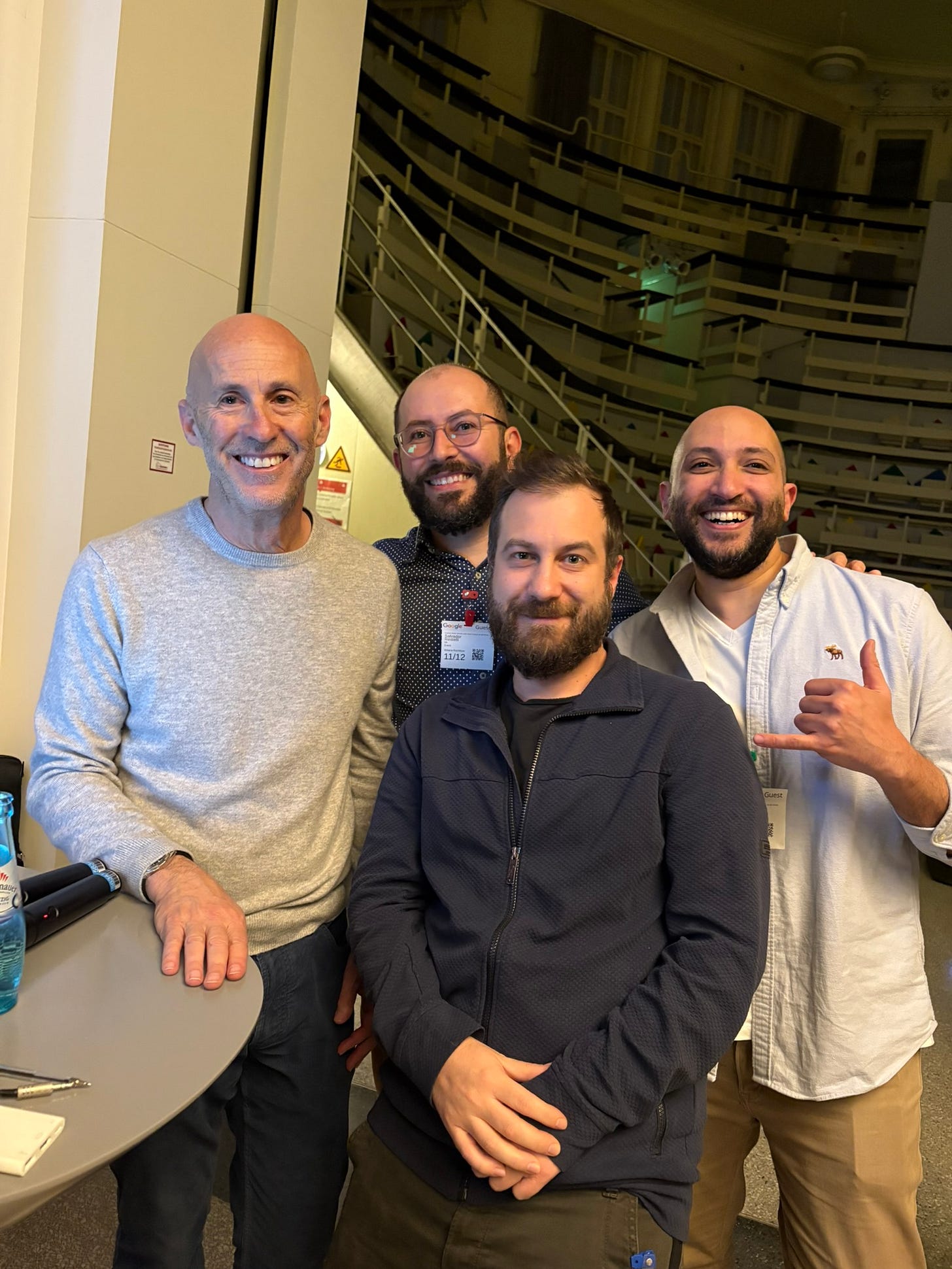One year since hosting Marty Cagan in Berlin
Reflections on Marty’s talk last year and how his message is more relevant than ever
One year ago today, we partnered with Delivery Hero and Google to host Marty Cagan for an intimate session with Berlin’s product community. It was our largest event to date, drawing 200 product builders and featuring a book signing line that stretched out the door.
The session was electric. Marty didn’t pull punches. He came to tackle “the hard stuff”. The painful truths that separate companies that consistently innovate from those that merely ship features.
A year later, after spending many hours talking to product builders and leaders across companies, I keep coming back to Marty’s insights. And in the age of AI revolution, they’re more relevant than ever.
What you’ll take away:
Why Europe’s addiction to process is becoming a competitive liability (especially now)
The three dimensions of the Product Operating Model and what’s missing in most companies
The hard truth about product management competencies in Europe
What I’m seeing change and what’s stubbornly staying the same
Let’s dig in!
The Setup: What Marty Covered
Marty centered his talk on the Product Operating Model — a shift from shipping features to achieving outcomes. It breaks down into three core dimensions:
How do you decide which problems to work on?
How do you solve those problems?
How do you build, test, and deploy solutions?
Marty also spent significant time on the critical competencies of product managers and product leaders
Before diving into the challenges, Marty gave some love to Berlin:
“When it comes to tech, Berlin is not really like the rest of Europe. And it’s not that the rest of Europe is bad, it’s just that Berlin is really good.”
But then he pivoted to the hard truths. And that’s where things got interesting.
1. Europe’s Addiction to Process
Marty called it out directly: Europe has a real addiction to process. And while he noted it’s “a global thing,” it’s especially prevalent in Germany.
The danger is that companies use the process “as a substitute for thinking.” This manifests as:
Prioritizing predictability over outcomes and innovation
Slowing down speed and agility to deliver value to customers
What I’ve observed over the last year:
Process continues to dominate how many companies work in Germany, with predictability and tight control treated as virtues. Many companies claim they’ve “transformed” because they:
Introduced some sort of Agile framework and have Project Managers labeled as Product Managers
Call their detailed work-tracking sheets “OKRs”
Name their teams after the Spotify model or a similar naming convention
But the core behavior remains top-down, output-driven processes:
Big-bang planning cycles with a function or executive in charge of strategy, deciding what needs to be built
Feature teams are asked to provide delivery plans with time estimates for prescribed solutions
Here’s the kicker: These are the same companies now trying to “sprinkle AI” on top of this culture and expecting massive efficiency gains and disruption.
If it was critical before for companies to understand the principles of the product model, with the rise of AI, the importance just grew exponentially.
The AI revolution should be a wake-up call. It’s an opportunity for European companies to use this moment as a change agent—to think deeply about what needs to fundamentally shift in how they work.
Europe has the talent and is well-positioned to do something extraordinary. It’s up to leaders and communities like ours to do our part to drive that change.

2. Deciding Which Problems to Work On: Product Vision and Strategy
Marty emphasized that deciding what to work on is both the hardest and most impactful dimension of the Product Operating Model.
The role of Product Leaders is critical here. They need to step up and:
Tackle real Product Vision and Product strategy
Take responsibility for coaching and developing their people
What I’ve observed over the last year:
In this area, I’m cautiously optimistic. I’ve seen strong positive signals over the past year.
Whether it’s:
The downsizing of big product companies
The rise of smaller AI startups
Increased capital availability
More experienced leaders moving to Europe from strong tech hubs in the US
There’s momentum. I’m seeing more experienced product leaders taking on leadership roles and pushing their organizations to get serious about Product Strategy and Product Vision.
3. How You Solve Problems: Discovery
Marty was crystal clear about the problem with most companies:
“In most companies, the stakeholders drive a roadmap, which is a prioritized list of projects and features. The thing about those projects and features is most of the time—like 90-plus percent of the time—they are solutions, potential solutions. The product team is not there to solve the problem; they are there to implement that solution.”
What I’ve observed over the last year:
Many companies have resisted product discovery because exploring options is perceived as:
Too expensive
Too slow
Unnecessary (because “someone already knows the solution”)
But AI is changing that perception in interesting ways, as many people outside tech see how easy it is now to build working prototypes.
Yes, there’s a risk that people now think building is easy and skip discovery altogether. But used properly, AI can help product teams bring optionality back into the conversation and demonstrate the power of discovery. Teams can now:
Build prototypes faster than ever
Iterate in real-time at lightning speed and minimal cost
Show (not tell) stakeholders the value of exploring alternatives before committing to a single path
This lowers both the perceived and real cost of discovery and makes it easier to advocate for the right way of working.
The key is using AI as a tool for learning and validation, not just faster execution of untested ideas.
4. How You Build
Marty didn’t mince words:
“We should have passed this one by now, except that the process people took over and some companies are still working with monthly or even quarterly releases. Teams should release at least every 2 weeks. The goal should be continuous deployment”
What I’ve observed over the last year:
Companies are quite advanced now and releasing continuously or every 1-2 weeks. It seems like SAFe lost its traction; it’s hard to hear about it anymore.
Companies are becoming more efficient at delivering features. After years of operating with the feature and delivery model, they’ve gotten good at execution. But the real challenge lies in deciding which problems to work on and conducting proper product discovery.
This is the fundamental issue—because a highly efficient feature factory, no matter how well-oiled, is not what the product operating model is about.
5. Product Managers and Product Leaders
What Marty Said
On Product Managers:
“On a feature team, a Product Manager is definitely not responsible for value and viability. The job is to gather the requirements, usually from the stakeholders, get them to the designer, get them to the engineers at sprint planning, make sure the thing gets built, tested, and deployed. That’s called project management”
“In an empowered product team the Product Manager is a shaper, is a maker”
On Product Leaders:
“Product leaders need to step up if they want to move to the product model. Part of stepping up is tackling real Product vision and Product strategy. Another part is taking real responsibility for coaching and developing their people.”
What I’ve observed over the last year:
On Product Managers:
The “delivery and feature team” model is still pervasive in Germany. Many “Product Managers” act as facilitators focused on requirement gathering and sprint coordination, and are not responsible for value and viability.
Most of the product managers are aware of this situation and are working hard on upskilling themselves to become true product managers. They are trying to do what’s within their power to change how their companies work. There’s a lot of appetite and willingness to improve, but we still have a way to go.
On Product Leaders:
As previously mentioned, this is an area where things seem to be showing good early signs, with strong product leaders entering the market in Germany and Europe (and other strong product managers growing into the role).
However, there are still many companies with Product Leaders who have never done true Product Management and are simply not capable of coaching their people effectively and driving the change their companies need (e.g., Product Strategy, Product vision, etc.)
Your Turn: What Are You Seeing?
I’d love to hear from you:
What challenges are you seeing in your organization? Is it process addiction? Lack of discovery? Competency gaps?
What positive changes are you noticing? Are you seeing product leaders step up? Teams embracing discovery? New ways of working?
How is AI changing the equation for you? Is it making things better or worse?
Drop a comment below or connect with me on LinkedIn. Let’s learn from each other!
On a personal note, I want to thank
for introducing me to Daniele and for helping to plan this event across ProductLab, DeliveryHero, and Google. Wafaey is a true example of a great Product Leader and someone who gives so much to the product community.




